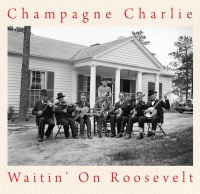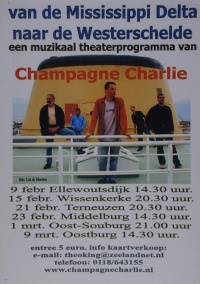Champagne Charlie: verschil tussen versies
k |
|||
| Regel 1: | Regel 1: | ||
| + | [[Bestand:vlag-Verenigd-Koninkrijk.jpg|25px]][[{{English: Champagne Charlie}} EN| Engelse vertaling / English translation]] | ||
| + | |||
{{Infobox | {{Infobox | ||
| band_naam = Champagne Charlie | | band_naam = Champagne Charlie | ||
Versie van 9 dec 2017 om 14:35
![]() [[
[[![]() Nederlandse versie / Dutch version
Nederlandse versie / Dutch version
| Champagne Charlie (1988 – Present) |
|---|
Bluesband. Occupation (roles) (2012):
- Geert de Heer: acoustic steel guitar, mandoline, mandoline-banjo, plectrum banjo, dobro, lap steel and electric guitar
- Peer Bout: contrabass, acoustic bass guitar and electric bass guitar
- Peter Lenselink: percussion instruments and background vocals
- Gait Kleinkromhof: harmonica
- Sjef Hermans: vocals, acoustic guitar and banjo
- Theo Koning: finger picking- and slide guitar on 6- and 12- string Flattops, electric guitar, banjo and vocals.
Inhoud
General
Champagne Charlie is a band from Zeeland whose sound draws from various types of blues music, often from 1920s to the 1950s. The band also incorporates many sub-genres, including American folk and roots music, but also R&B (rhythm and blues), and country blues.
Largely due to their American influence, most of Champagne Charlie’s songs are performed in English. However, occasionally the members covered and composed songs with Dutch lyrics. The six-manned ensemble’s arrival to the Zeeland popular music scene brought a fresh twist in the form of a quintessentially American blues influence. With their many releases eventually comprising an impressive discography, Champagne Charlie’s influence began to spread in Zeeland as well as in the Netherlands in general, and eventually spread throughout Europe.
Origins of Champagne Charlie
The conception and formation of the band begins with Sjef Hermans (whose role in the band involves vocals, acoustic guitar and banjo) and Theo de Koning (whose role in the band involves finger picking and slide guitar on six and twelve string flattops, the electric guitar, banjo, and vocals). The two met in the 1970s and quickly bonded over their mutual fascination with the blues. The two began playing music together, and were largely influenced by old gramophone records in their jam sessions. However, trying to imitate their idols was in fact more difficult than Hermans and de Koning had foreseen. As Hermans states, "We stubbornly tried to imitate the blues sound of our American examples. This proved to be an impossible task: we were solely two simple white boys from Zealand who had grown up in relative wealth and had barely experienced something shocking. Not really a good basis for singing the Blues." After listening to other white artists who tried to sing the blues, Hermans and de Koning came to the conclusion that they would simply have to find their own sound, rather than attempting to imitate one. This realization was extremely significant in the formation and development of their sound as a musical group.
After a year of intense practicing and giving family concerts, Hermans and de Koning decided it was time to showcase their projects for the local blues community. They began performing in blues clubs and other cafes; as they were not yet the fully formed Champagne Charlie, they performed under the musical name Delta Blue Boys (1977). As the pair became more well-known through these local blues gigs, their popularity spread throughout Zeeland.
It was not until eleven years later, on the 7th of June, 1988, that the band Champagne Charlie was truly born. The name of the band comes from an old song by the guitarist ‘Blind Blake’ called: "Champagne Charlie is My Name". The first official group called Champagne Charlie consisted of Sjef Hermans, Geert de Heer, Theo de Koning, Reindert Hofland, and Ad Lijnse. Soon Ad Lijnse was replaced by Peter Lenselink, and the band prepared for their first CD: a live recording in cafe Razzmatazz. The first album was thus called: ‘Live in Razzmatazz’, with the abum’s debut being presented on Queens Day in 1994. The audience and critics were positive about the first CD. Among the admirers were Rien Wisse, editor of the Dutch blues magazine 'Block', who invited Champagne Charlie to join a project, in which a CD was produced to celebrate the 25th anniversary of his magazine. The end result was 'No Less Than Wireless'. a collection of acoustic blues songs by different Dutch blues bands including Champagne Charlie.
As of today the band consists of six men: Geert de Heer (who plays the acoustic steel guitar, mandolin, mandolin-banjo, plectrum banjo, electric guitar, and the Dobro), Peer Bout (who plays the upright bass, the acoustic bass guitar, and the electric bass guitar) Peter Lenselink (who plays the percussion instruments and backing vocals), Gait Kleinkromhof (who plays the harmonica), frontman Sjef Hermans (whose role involves vocals, acoustic guitar, banjo), and finally Theo Koning (whose role involves finger picking and slide guitar on six and twelve string flattops, the electric guitar, banjo, and vocals).
Works with RSC and Four Freedom Awards
The picture above depicts the band’s performance at the celebration of the 25th anniversary of the Roosevelt Study Centre. Champagne Charlie can also be found in brochures of the RSC. The collaboration between the research institution and the band began in 2008, when Champagne Charlie was invited to perform at the Four Freedom Awards. This feature performance went successfully and, following, the band was also asked to perform at the 25th anniversary of the Roosevelt Study Centre. Champagne Charlie went on to record two CD’s with the help of the Roosevelt Study Centre: Waitin’On Roosevelt and Hobo Signs and Railroad Lines.
The band received a large amount of positive feedback from a variety of sources, and varied places. Some examples of their widespread influence can be found in folk magazine ‘Dirty Linen’ and American blues Professor Dr. David Evans. One of the albums, ‘'Hobo Signs & Railroad Signs’', can even be found in the Hobo Museum, Britt, Iowa.
Discography
- Live in Razzmatazz (1994)
- No Less Than Wireless (1995)
- Round ’n’ Round (1997)
- Volle Maan ( 2001)
- Laatste Afvaart (2002)
- Allemaal Anders (2002)
- Tkanookanders (2004)
- De Ramp (2005) cd single
- Mr Charlie’s Blues (2005)
- Down The Road (2007)
- Waitin’ On Roosevelt (2008)
- Hobo Signs and Railroad Lines (2011)
- America through the eyes of Woody (2013)
Author
-Marlin Wagtmans (UCR), 2012.
Editors
Sabine Pendry (UCR), 2017.; Jordan Scott (UCR), 2017.
Sources
-Champagne Charlie – Homepage (S.l., s.a.) 15 maart 2012.
-Interview with Sjef Hermans from Marlin Wagtmans, 6 March 2012.
-Hermans, Sjef, ‘Van de Mississippi Delta naar de Westerschelde De Zeeuwse blues van Champagne Charlie’, in: Zeelandboek (Lente 2002) 179 - 198. EN| Engelse vertaling / English translation]]
| Champagne Charlie (1988 – Heden) |
|---|
Bluesband. Bezetting (2012):
- Geert de Heer: akoestische steelgitaar, mandoline, mandoline-banjo, plectrum banjo, dobro, lapsteel en elektrische gitaar
- Peer Bout: contrabas, akoestische basgitaar en elektrische basgitaar
- Peter Lenselink: percussie-instrumenten en achtergrondzang
- Gait Kleinkromhof: mondharmonica
- Sjef Hermans: zang, akoestische gitaar en banjo
- Theo Koning: finger picking- en slide gitaar op zes- en twaalfsnarige Flattops, elektrische gitaar, banjo en zang.
Algemeen
Champagne Charlie is een band die verschillende soorten bluesmuziek speelt uit de periode van 1920 tot 1950. Het repertoire omvat vele sub-genres, waaronder Amerikaanse folk- en rootsmuziek, maar ook rhythm-and-blues en country blues. De band speelt voornamelijk Engelstalige muziek, maar ook enkele Nederlandstalige nummers. Deze groep mannen zorgt voor een verrassende, vernieuwende wending in de populaire muziek in Zeeland. Met een indrukwekkende discografie lukt het Champagne Charlie om door te breken buiten Zeeland, Nederland en zelfs Europa.
Ontstaan van Champagne Charlie
In 2013 vierde de band zijn 25-jarig bestaan. Het idee om Afro-Amerikaanse blues te gaan spelen komt van Sjef Hermans, de zanger van de huidige band, die gefascineerd is door de blues als muziekgenre in de jaren ‘60. Hij werkte samen met Theo de Koning, die Hermans een "geestverwant" noemt als het gaat om muzikale smaak. Het duo begon samen muziek te maken en raakte beïnvloed door oude krakende grammofoonplaten. Ze probeerden hun idolen te imiteren, maar dit bleek moeilijker dan verwacht. Na het beluisteren van andere blanke muzikanten die ook Afro-Amerikaanse blues probeerden te zingen kwamen Hermans en Koning achter een cruciale waarheid: ze moesten hun eigen geluid vinden. Dit besef was heel belangrijk voor de toekomst van de band.
Na een jaar van intensief oefenen en het geven van verscheidende familieconcerten, vonden de twee mannen dat het tijd was om de bluesgemeenschap te laten oordelen over hun muzikaliteit. Zodra ze begonnen met het optreden in blues clubs - nog niet als Champagne Charlie, maar als de Delta Blue Boys in 1977- en andere cafés, werden mensen enthousiast over hun muziek. Dit alles resulteerde in een aantal belangrijke ontwikkelingen, zowel qua populariteit als qua bandformatie. Door de jaren heen kende de voorloper van Champagne Charlie ups en downs. Het was pas 11 jaar later, op 7 juni 1988, dat de band Champagne Charlie ontstond. De naam werd afgeleid van een oud nummer van gitarist Blind Blake: Champagne Charlie is My Name. De officiële eerste leden van Champagne Charlie waren Sjef Hermans, Geert de Heer, Theo de Koning, Reindert Hofland en Ad Lijnse. Al snel werd Ad Lijnse vervangen door Peter Lenselink, en de band bereidde zich voor op hun eerste cd: een live-opname in Razzmatazz in Souburg. Het was dan ook geen verrassing dat het eerste album Live in Razzmatazz heette. Het debuutalbum werd gepresenteerd op Koninginnedag in 1994. Het publiek en critici waren positief over deze eerste CD. Onder de bewonderaars was Rien Wisse, redacteur van Block, het Nederlandse blues magazine. Hij nodigde Champagne Charlie uit om aan een project mee te werken. Dit resulteerde in het tweede album No Less than Wireless: een verzameling van akoestische blues songs van verschillende Nederlandse blues bands, waaronder Champagne Charlie.
Samenwerking met RSC en Four Freedom Awards
De band trad op bij de viering van het 25-jarig jubileum van het Roosevelt Study Centre (tegenwoordig Roosevelt Institute voor American Studies, ook wel RIAS). Champagne Charlie is ook te vinden in brochures van het RIAS. Deze interessante relatie tussen de onderzoeksinstelling en de band begon in 2008 toen de band werd gevraagd een cd te maken over Franklin Delano Roosevelt: Waitin’ On Roosevelt en op te treden bij de Four Freedom Awards. Deze samenwerking verliep zo vlot dat de band ook mocht optreden op de 25ste verjaardag van de onderzoeksinstelling. De band produceerde zelfs een tweede cd in samenwerking met het Roosevelt Study Centre: Hobo Signs and Railroad Lines. Champagne Charlie kreeg lovende reacties. Voorbeelden daarvan zijn door folktijdschrift Dirty Linen en de Amerikaanse musicoloog Dr. David Evans geschreven.
Discografie
- Live in Razzmatazz (1994)
- No Less Than Wireless (1995)
- Round ’n’ Round (1997)
- Volle Maan ( 2001)
- Laatste Afvaart (2002)
- Allemaal Anders (2002)
- Tkanookanders (2004)
- De Ramp (2005) cd single
- Mr Charlie’s Blues (2005)
- Down The Road (2007)
- Waitin’ On Roosevelt (2008)
- Hobo Signs and Railroad Lines (2011)
- America through the eyes of Woody (2013)
Auteur
-Marlin Wagtmans (UCR), 2012.
Bronnen
-Champagne Charlie – Homepage (S.l., s.a.) 15 maart 2012.
-Interview met Sjef Hermans door Marlin Wagtmans, 6 maart 2012.


